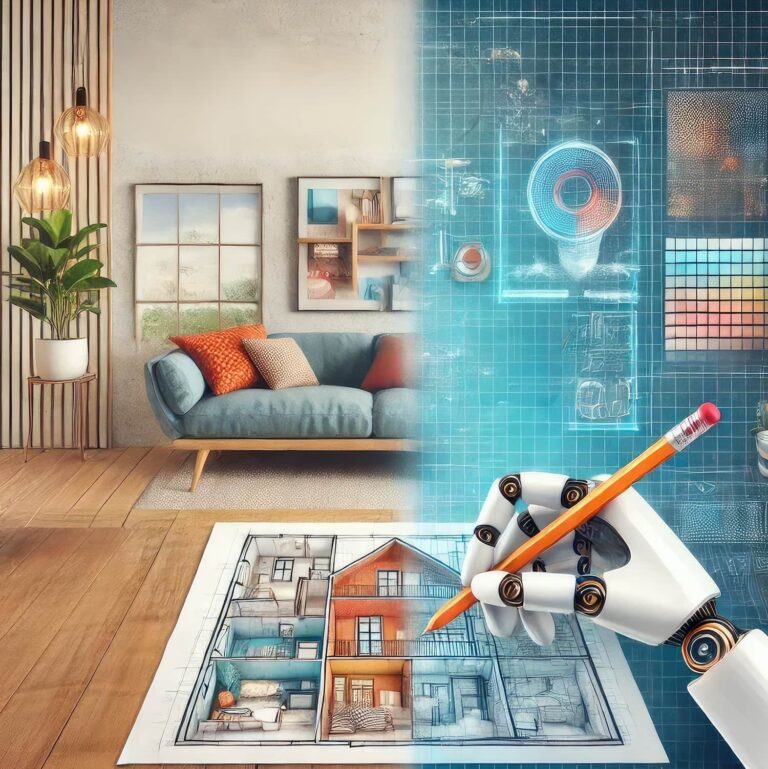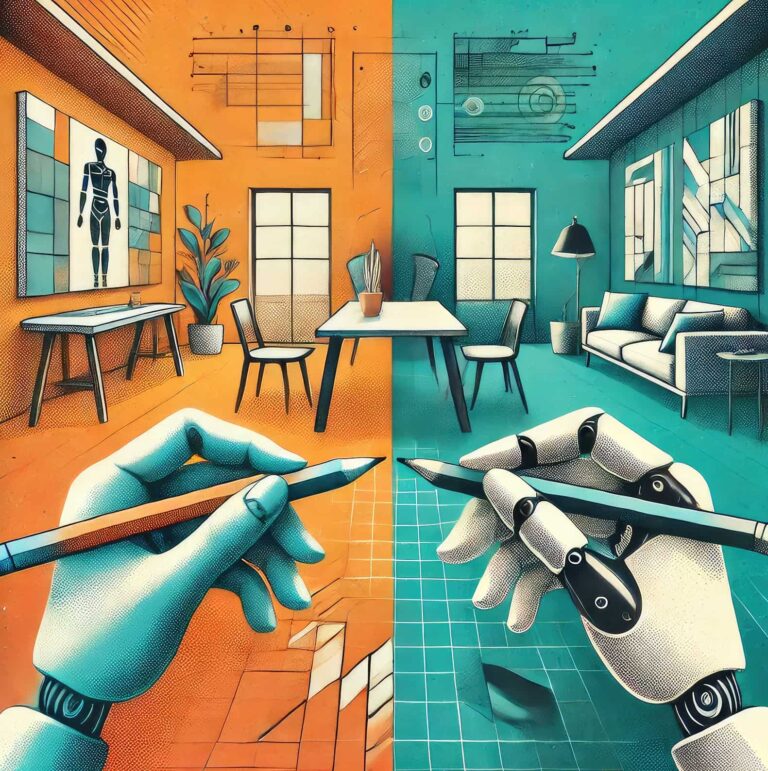 Skip to content
Skip to content
The use of Artificial Intelligence (AI) in interior design refers to the use of machine learning and automation to streamline design processes. These tools are used to analyze data, generate recommendations, and create visualizations, making the design process faster and more efficient. For example, platforms like Planner 5D and DecorMatters allow users to input their preferences and instantly see rendered design suggestions tailored to their needs.
AI excels in automating repetitive tasks like generating 3D visualizations, optimizing layouts, and suggesting furniture arrangements based on spatial data. For instance, AI algorithms can predict the best lighting schemes for a room by analyzing its dimensions and natural light availability. These capabilities can reduce the time spent on trial-and-error processes and allow designers to focus more on creative aspects of a design.
The use of AI tools are becoming increasingly popular in the industry. Programs like Fotor’s AI interior design tool help users visualize transformations, while DecorMatters offers customization options for layouts and furnishings. These platforms cater to homeowners seeking DIY solutions as well as professionals aiming to speed up preliminary design phases.
AI technology reduces the workload on designers by handling time-consuming tasks. For instance, it can quickly generate multiple layout options for a single room, letting designers and clients evaluate choices without extensive manual drafting. By saving time, AI allows for a more refined focus on creativity and personalization.

Interior design is not only about aesthetics; it is deeply intertwined with understanding a client’s identity, values, and lifestyle. Designers translate intangible emotions and desires into tangible spaces. A designer might notice that a client speaks fondly of a family vacation, weaving elements of that memory—like Mediterranean tiles or tropical plants—into the design. This ability to craft deeply personal and meaningful spaces goes beyond what AI can achieve.
Additionally, cultural understanding plays a crucial role in design. Designers draw from their own experiences and nuanced knowledge of diverse traditions to incorporate elements like Feng Shui principles or traditional European craftsmanship. AI may offer generalized suggestions, but it cannot interpret the cultural and emotional significance of design choices the way a human can.
AI operates within the boundaries of its programming and existing datasets. While it can generate aesthetically pleasing designs, it often lacks the originality that comes from human intuition and creative risk-taking. Human designers, on the other hand, thrive on experimentation, drawing inspiration from unexpected places—a walk in nature, an abstract painting, or even a client’s favorite piece of music.
For example, a human designer might decide to repurpose antique furniture or use unconventional materials, such as recycled ocean plastics, to tell a story about sustainability. These creative leaps often result in designs that defy trends and stand the test of time. This kind of innovation—where art meets function—remains a uniquely human capability.
While AI excels at data analysis and technical tasks, it struggles with emotional intelligence and subjective interpretation. For instance, an AI tool might recommend a sleek, modern design for a client based on their online behavior, but it cannot sense that the client’s hesitant tone indicates a preference for something warmer and more traditional.
Additionally, AI lacks the ability to adapt on the fly during client consultations. A human designer can pick up on subtle cues, like a change in body language or an offhand comment, and adjust the direction of the project immediately. These real-time, empathetic interactions are pivotal to creating designs that truly resonate with clients.
AI’s strength lies in its ability to execute technical tasks with speed and precision. It can measure dimensions, generate 3D models, and optimize spatial layouts based on mathematical algorithms. However, the creative aspect of design—envisioning a cohesive theme, balancing textures, and imagining how a space will feel when inhabited—requires a level of artistry and emotional intelligence that AI cannot replicate.
For example, a designer tasked with creating a “Modern Serenity” theme might interpret it by blending cool tones, natural materials, and minimalistic furniture to evoke calmness. AI might suggest individual elements that align with modernity and serenity but lacks the ability to weave them into a unified narrative.
AI is most effective when viewed as an extension of a designer’s toolkit, not a replacement. By handling mundane tasks—like drafting floor plans or generating initial layout options—AI frees up designers to focus on higher-value activities like building client relationships and refining creative concepts.
This collaborative dynamic enhances both productivity and quality. For instance, an AI program can generate a dozen lighting configurations for a space in minutes, allowing the designer to select the most suitable option and customize it further. This partnership ensures that the final design is both data-informed and artistically refined.
Additionally, the integration of AI into the design process democratizes certain aspects of design, making tools accessible to a wider audience. However, it also elevates the role of professional designers, as their expertise becomes the defining factor in transforming AI-generated concepts into personalized, meaningful spaces.

The rapid evolution of AI technology is poised to redefine the interior design landscape in the coming years. One of the most exciting trends is the integration of AI with virtual reality (VR) and augmented reality (AR). These tools are expected to become standard in client-designer collaborations, offering immersive experiences where clients can “walk through” a 3D rendering of their space before any physical changes are made. Imagine exploring multiple design options, changing colors, materials, or layouts in real-time, all guided by your designer.
Another anticipated trend is the rise of predictive design, where AI analyzes a client’s lifestyle patterns, preferences, and even physiological data (like stress levels) to suggest design elements that promote well-being. For example, AI might recommend biophilic design elements—such as indoor plants or natural light optimization—for clients who spend long hours indoors.
Sustainability is another area where AI is likely to make a significant impact. Tools are being developed to calculate the environmental footprint of design choices, helping designers create eco-friendly spaces by selecting sustainable materials, energy-efficient layouts, and repurposed furnishings. This aligns with the growing demand for conscious, planet-friendly design solutions.
The integration of AI into interior design workflows is inevitable, but its role will likely evolve as a supportive rather than a dominant force. Industry experts predict that AI will become a standard tool in every designer’s toolkit, much like CAD software and 3D rendering tools are today. This shift will encourage designers to embrace AI as a partner in creativity, allowing them to work smarter, not harder.
As AI becomes more prevalent, the focus will shift from viewing it as a threat to recognizing its empowering potential. Designers who adopt AI tools early will gain a competitive edge, as they’ll be able to deliver faster, more accurate, and highly personalized solutions to their clients. Over time, the distinction between “AI-assisted design” and traditional design will blur, with most projects involving some level of collaboration between AI and human expertise.
However, AI’s normalization in the industry will also come with challenges. Designers will need to strike a balance between leveraging AI’s efficiency and maintaining their artistic identity. Over-reliance on AI-generated solutions risks creating homogenized, impersonal designs, which could devalue the bespoke nature of professional interior design.
Ultimately, while AI will become a norm, its success will hinge on its ability to enhance—rather than replace—the creative touch of a human. The future of interior design lies in this harmonious blend, where AI amplifies human creativity and intuition, enabling designers to push the boundaries of what’s possible.
While AI has revolutionized the interior design industry, it cannot replicate the artistry, intuition, and emotional depth that human designers bring to their work. By embracing AI as a tool rather than a competitor, designers can unlock new levels of efficiency and creativity. For clients and professionals alike, the future promises a harmonious blend of technology and human ingenuity.